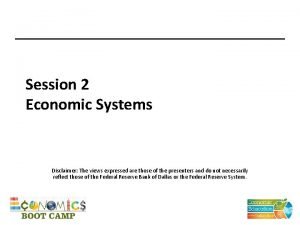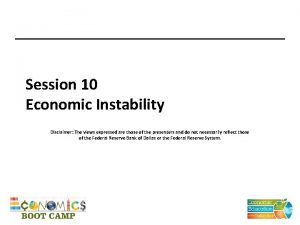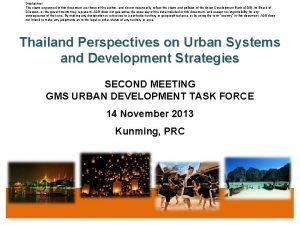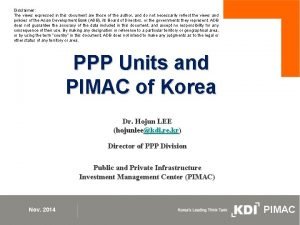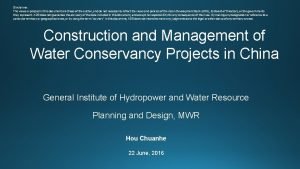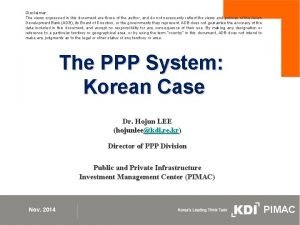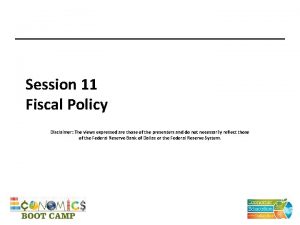Disclaimer The views expressed in this document are


























- Slides: 26

Disclaimer: The views expressed in this document are those of the author, and do not necessarily reflect the views and policies of the Asian Development Bank (ADB), its Board of Directors, or the governments they represent. ADB does not guarantee the accuracy of the data included in this document, and accept no responsibility for any consequence of their use. By making any designation or reference to a particular territory or geographical area, or by using the term “country” in this document, ADB does not intend to make any judgments as to the legal or other status of any territory or area. How IIFCL Became The Flagship Infrastructure Financing Institution in South Asia? Evolution of ADB’s Involvement in Infrastructure Financing in India ─ from PSIF (PSP) to IIPFFs (PPP) 6 th PRC-ADB KNOWLEDGE SHARING PLATFORM: DEEPENING PUBLIC-PRIVATE PARTNERSHIPS CHEOLSU KIM South Asia Department Asian Development Bank

Children at a PPP project site in Gujarat, India


Definition of Public-Private Partnership (Source: ADB Public-Private Partnership Handbook) n Principle of PPP- Risk Allocation: The structure of the PPP should be designed to allocate risks to the entities/partners that are best able to manage the risks and thus minimize costs while improving efficiency and performance. n Public-Private Partnership (PPP): While engaging the private sector, PPP presents a framework that acknowledge and structure the role for government in ensuring that social obligations are met, and successful sector reforms and public investments are achieved. n Private-Sector Participation (PSP): While engaging the private sector, PSP contracts transfer obligations to the private sector rather than emphasizing the opportunity for partnership.

ADB Strategy 2020: Emphasis on PPP ADB Strategy 2020 on PPP: Under Strategy 2020, ADB's infrastructure operations will emphasize PPPs and PSP. ADB will promote a larger role for the private sector in financing infrastructure, either as a project sponsor or as an institutional bond or equity investor, which will augment the supply of capital for infrastructure in developing the region. However, improvements in a country's domestic debt market will be indispensable for increasing the flow of long-term funds into infrastructure development. PPP in South Asia: Public sector has been the main provider of basic infrastructure in South Asia. However, public financing will not alone be able to generate the needed levels of investments to improve infrastructure facilities. Recognizing the significance of the role of private sector in infrastructure development, Governments of South Asia have placed PPPs and PSP at the center of their infrastructure development.

Evolution of Public-Private Partnership in India* (*Sources: ADB, PPP India Database as of 31 March 2014, and Ernst &Yong) Phase I: 19 th century and early 20 th century India ADB Few notable PPPs could be found as early as 19 th century: The Great Indian Peninsular Railway Company (1853) The Bombay Tramway Company’s tramway services in Mumbai (1874) PPP models were there in power generation and distribution in Mumbai and Kolkata in the early 20 th century Phase II: 1991– 2006 Phase III: After 2006 Only 86 PPP projects were awarded till 2004 Most of the projects were in bridges and roads sector in the form of PSP Large-scale private financing has been limited to Vishakapatnam water supply proejct and Tirupur water and wastewater project in Tamil Nadu. Increasing acceptance of PPP model due to favorable policy reforms and innovative PPP structures Growth in PPP from 150 projects in November, 2006 to 758 projects in 2011, and 1339 PPP projects in March 2014 PSP PSIF II PPP IIPFF II AIIFI ADB = Asian Development Bank, AIIFI = Accelerating Infrastructure Investment Facility in India, IIPFF = India Infrastructure Project Financing Facility, PPP = public-private partnership, PSIF = Private Sector Infrastructure Facility, PSP = Private Sector Participation

Evolution of Development Banks for Infrastructure Financing FINANCIAL SECTOR REFORM • ICICI/IDBI (Industrial Bank to Universal Bank) • Privatization of IDFC/IL&FS GOI’s Initiatives Establishment of IIFCL Financial Institutions: IDFC/IL&FS/IFCL Banks: ICICI/IDBI 1997 1998 1999/2000 2003 -2005 U. S. Sanction in India (May 1998) Private Sector Infrastructure Facility (PSIF) for Private Sector Participation (PSP) ($200 million) FINANCIAL INSTITUTIONS Jan 2006 PPP Trends in India PSIF II ($300 million) Constraints with PSP Sub-prime Mortgage Crisis 2007 2008 India Infrastructure Project Financing Facility (IIPFF) ($500 million) 2009 India Infrastructure Project Financing Facility II (IIPFF II) ($700 million) 2013 Accelerating Infrastructure Investment Facility in India ($700 million) 7 PPP TAs: Mainstreaming PPPS PPP Process Flow Framework for Developing Infrastructure through PPP and PSP Performance Charts (IIPFF I & II) IDFC: Infrastructure Development Finance Company IL&FS: Infrastructure Leasing & Financial Services Ltd. IDBI: Industrial Development Bank of India BANKS Photos of PPP subprojects

Constraints with PSP Participation n n What is inhibiting the private sector from making investments in infrastructure and what can be done to overcome those inhibitions? n High Risk-High Return vs High Risk-low or negative return? Why is there a shortage of bankable projects? n Lack of enabling environment, lack of experience, lack of capacity etc. n IDBI withdrew from the facility in November 2003 due to paucity of bankable sub-projects from the selected states. Go back

IDBI all set to become India's largest bank (source: Silicon. India, Tuesday, 31 August 2004) NEW DELHI: The Ministry of Finance (Mo. F) is considering a proposal to merge two infrastructure-financing institutions � IL&FS and IDFC � with the IDBI. This merger is expected to transform IDBI into a mega-financial institution � with one arm doing commercial banking, the size of which could be comparable to that of State Bank of India (SBI) and the other arm playing the role of a developmental financing institution, similar to what it has been doing since its inception. The main focus of the institution would continue to be long-term funding. These two institutions would be third and fourth institutions to be merged with IDBI � if the formalities go through in due course. This would precede the merger of IFCI with IDBI, as the valuation of the assets of IFCI is expected to take time. The merger of IL&FS and IDFC with IDBI would remove any duplication in infrastructure financing and will create one big entity for the same purpose. It would add to the strength of IDBI as a bank, as the scope for fee-based activities would rise, with IL&FS already into infrastructure, particularly roads and bridges. Go back

Government Initiatives on PPPs n Establishing a PPP cell in Mo. F (Department of Economic Affars) for coordination of PPP mainstreaming n Institutionalizing PPP cells in selected states and central line ministries for identification of PPP opportunities n Establishing India Infrastructure Project Development Fund for financing PPP project preparation activities n Establishing the IIFCL for facilitating access to long-term funds (with tenor of no less than 10 yrs) for infrastructure development n Launching the Viability Gap Fund (up to 40% of total project cost) n Creating Model Concession Agreements (MCA) in priority sectors Go back

Process Flow of Developing and Operationalizing PPP Subprojects Go back

Framework for Developing Infrastructure through PPP and PSP Go back

Performance Chart PPP Subprojects Approved and Disbursed under IIPFFs and AIIFI Sector Airport Total Project Cost (Rs, million) 176, 358 Total Project Cost (USD, million) As of 31 Oct 2014 2, 876 % 170, 240 2, 776 17% Road 570, 531 9, 303 59% 58, 830 959 6% Total 975, 959 15, 914 Power 17% 18% Power Transmission & Distribution Airport 18% 100% Transmissio n& Distribution 6% Road 59%

Cont. Performance Chart IIPFF I and IIPFF II Disbursement (as of 30 September 2014) Facility IIPFF I Tranche (Date of Approval) Tranche 1 (20 Dec 2007) Tranche 2 (24 Feb 2009) Tranche Amount $300 million $200 million Disbursement (Date of completion) Fully Disbursed (15 Jan 2010) Fully Disbursed (26 Aug 2011) Fully Disbursed (14 Sept 2011) Subtotal 30 PPP Projects $500 million IIPFF II Tranche 1 (27 Nov 2009) $210 million Tranche 2 (7 Dec 2010) $250 million Fully Disbursed (23 Oct 2012) Tranche 3 (1 Dec 2011) $240 million Fully Disbursed (14 May 2014) 20 PPP Projects $700 million Fully Disbursed (14 May 2014) 50 PPP Projects $1. 2 billion *Fund mobilization ratio > 12 times Subtotal TOTAL Go back

Cont. Road Sector

Cont. Delhi International Airport Construction Site

Aerial View, Terminal 3. Delhi International Airport

Cont. Aerial View, Mumbai International Airport An artist’s impression of the Mumbai International Airport after completion of modernization

Cont. Power Project in Gujarat

Power Project in Gujarat Go back

Cont. PPP Trends in India Source: Ernst and Young 2012 n Growing number of PPP infrastructure projects n From 66 projects between 1995 -2001 to over 150 between 20022006, and to 758 projects in 2011. As of 31 March 2014, India has a list of 1339 PPP projects. n Growth was mainly in the transport and urban infrastructure projects.

Cont. PPP Trends in India n Rising Debt-Equity Ratio n Increased comfort level of commercial banks in financing PPP projects n Concession terms encourage use of debt over equity n PPP Financing n Debt Financing n 70 % of senior debt provided by commercial banks (80% of this by public sector banks) n Limited use of subordinated debt (mostly used in the road sector) n Higher gearing for projects with viability gap funds and negative grants n Fall in average spreads on debt of PPP projects due to financial markets’ growing acceptance and understanding of PPPs n Higher tenor and shorter reset periods of debt

PPP Trends in India n PPP Financing n Equity Financing n 80% of equity comes from project developers n Higher expected equity returns for projects with higher gearing n Low participation of foreign players, particularly strategic investors n Reluctance of pure equity providers to invest directly in SPVs due to concession agreements restrictions on the sale of developers’ equity. Go back

How IIFCL Became the Flagship PPP Infrastructure Financing Intuition? n Market Evolution: Market demanded the policy reform n Go. I’s Enabler: PPP framework/guidelines, IIFCL, VGF, MCA etc. n SIFTI: The well thought through operational mandate of IIFCL (Coincides with market evolution) n Resources: Guarantee support of the government - internal and external borrowings coupled with timely equity injection. n Support of and Strong Partnership with ADB: Lending, capacity building and other advisory assistance extended by ADB.

Lessons Learned n Sustainability of PPPs: Issue on heavy reliance on commercial banks for debt financing needs to be addressed n ALM (Asset-Liability Mismatch) n The need for an active and efficient bond market n Growth is hampered by institutional, legal, and regulatory constraints that make bond more expensive way of debt financing n Innovations, innovations! n IIFCL has shown its effectiveness in facilitating the PPP agenda of government. However, more innovative financing instruments and modalities are required to accommodate the need of the market effectively and efficiently.

Thank you
 The views and opinions expressed
The views and opinions expressed Views expressed disclaimer
Views expressed disclaimer Economics systems
Economics systems All views expressed disclaimer
All views expressed disclaimer Views disclaimer
Views disclaimer The opinions expressed
The opinions expressed Disclaimer the views expressed
Disclaimer the views expressed The views expressed disclaimer
The views expressed disclaimer Antigentest åre
Antigentest åre All opinions expressed disclaimer
All opinions expressed disclaimer Disclaimer about opinions expressed
Disclaimer about opinions expressed The views and opinions expressed
The views and opinions expressed Document.write(document.cookie)
Document.write(document.cookie) đại từ thay thế
đại từ thay thế Vẽ hình chiếu vuông góc của vật thể sau
Vẽ hình chiếu vuông góc của vật thể sau Công của trọng lực
Công của trọng lực Thế nào là mạng điện lắp đặt kiểu nổi
Thế nào là mạng điện lắp đặt kiểu nổi Tỉ lệ cơ thể trẻ em
Tỉ lệ cơ thể trẻ em Lời thề hippocrates
Lời thề hippocrates Dạng đột biến một nhiễm là
Dạng đột biến một nhiễm là Vẽ hình chiếu đứng bằng cạnh của vật thể
Vẽ hình chiếu đứng bằng cạnh của vật thể Phản ứng thế ankan
Phản ứng thế ankan Quá trình desamine hóa có thể tạo ra
Quá trình desamine hóa có thể tạo ra Môn thể thao bắt đầu bằng từ chạy
Môn thể thao bắt đầu bằng từ chạy Khi nào hổ con có thể sống độc lập
Khi nào hổ con có thể sống độc lập điện thế nghỉ
điện thế nghỉ Thế nào là sự mỏi cơ
Thế nào là sự mỏi cơ


